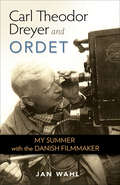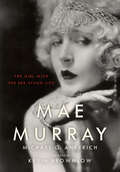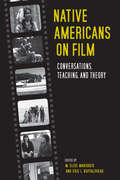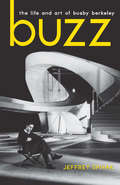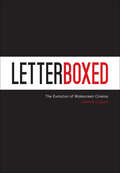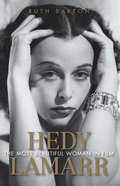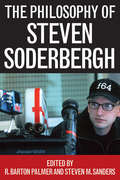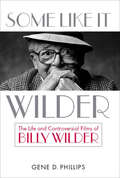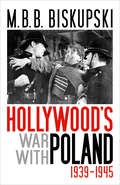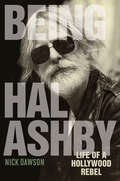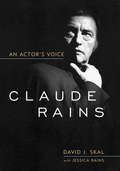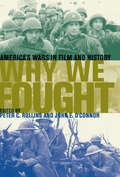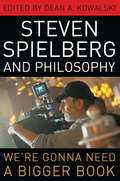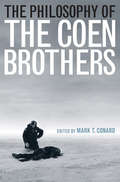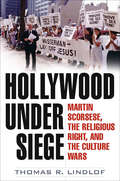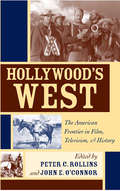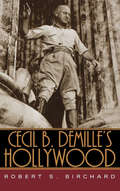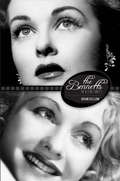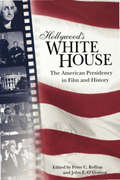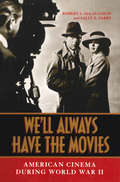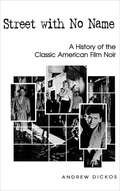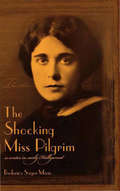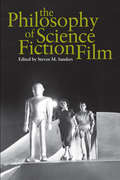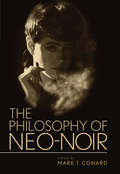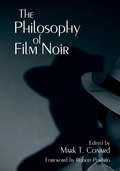- Table View
- List View
Carl Theodor Dreyer and Ordet: My Summer with the Danish Filmmaker (Screen Classics)
by Jan WahlThis illustrated memoir shares a rare inside look at the legendary director’s process and vision during the filming of his award-winning masterpiece.Danish director Carl Theodor Dreyer is considered one of the most influential filmmakers in cinematic history. His 1955 film Ordet (The World) won numerous prizes, including the Venice Film Festival’s Golden Lion. In 1954, Dreyer invited young film student Jan Wahl to accompany him during this classic work.This captivating account of Wahl's time with the director is based on Wahl's daily journal and transcriptions of his conversations with Dreyer. Offering a glimpse into the filmmaker's world, Wahl fashions a portrait of Dreyer as a man, mentor, friend, and director. Wahl's detailed account is supplemented by exquisite photos of the filming and by selections from Dreyer's papers, including his notes on film style, his introduction for the actors before the filming of Ordet, and a visionary lecture he delivered at Edinburgh.
Mae Murray: The Girl with the Bee-Stung Lips (Screen Classics)
by Michael G. AnkerichMae Murray (1885--1965), popularly known as "the girl with the bee-stung lips," was a fiery presence in silent-era Hollywood. Renowned for her classic beauty and charismatic presence, she rocketed to stardom as a dancer in the Ziegfeld Follies, moving across the country to star in her first film, To Have and to Hold, in 1916. An instant hit with audiences, Murray soon became one of the most famous names in Tinseltown.However, Murray's moment in the spotlight was fleeting. The introduction of talkies, a string of failed marriages, a serious career blunder, and a number of bitter legal battles left the former star in a state of poverty and mental instability that she would never overcome.In this intriguing biography, Michael G. Ankerich traces Murray's career from the footlights of Broadway to the klieg lights of Hollywood, recounting her impressive body of work on the stage and screen and charting her rapid ascent to fame and decline into obscurity. Featuring exclusive interviews with Murray's only son, Daniel, and with actor George Hamilton, whom the actress closely befriended at the end of her life, Ankerich restores this important figure in early film to the limelight.
Native Americans on Film: Conversations, Teaching, and Theory
by M. Elise Marubbio and Eric L. Buffalohead“An essential book for courses on Native film, indigenous media, not to mention more general courses . . . A very impressive and useful collection.” —Randolph Lewis, author of Navajo Talking PictureThe film industry and mainstream popular culture are notorious for promoting stereotypical images of Native Americans: the noble and ignoble savage, the pronoun-challenged sidekick, the ruthless warrior, the female drudge, the princess, the sexualized maiden, the drunk, and others. Over the years, Indigenous filmmakers have both challenged these representations and moved past them, offering their own distinct forms of cinematic expression.Native Americans on Film draws inspiration from the Indigenous film movement, bringing filmmakers into an intertextual conversation with academics from a variety of disciplines. The resulting dialogue opens a myriad of possibilities for engaging students with ongoing debates: What is Indigenous film? Who is an Indigenous filmmaker? What are Native filmmakers saying about Indigenous film and their own work? This thought-provoking text offers theoretical approaches to understanding Native cinema, includes pedagogical strategies for teaching particular films, and validates the different voices, approaches, and worldviews that emerge across the movement.“Accomplished scholars in the emerging field of Native film studies, Marubbio and Buffalohead . . . focus clearly on the needs of this field. They do scholars and students of Native film a great service by reprinting four seminal and provocative essays.” —James Ruppert, author of Meditation in Contemporary Native American Literature“Succeed[s] in depicting the complexities in study, teaching, and creating Native film . . . Regardless of an individual’s level of knowledge and expertise in Native film, Native Americans on Film is a valuable read for anyone interested in this topic.” —Studies in American Indian Literatures
Buzz: The Life and Art of Busby Berkeley (Screen Classics)
by Jeffrey SpivakCharacterized by grandiose song-and-dance numbers featuring ornate geometric patterns and mimicked in many modern films, Busby Berkeley's unique artistry is as recognizable and striking as ever. From his years on Broadway to the director's chair, Berkeley is notorious for his inventiveness and signature style. Through sensational films like 42nd Street (1933), Gold Diggers of 1933 (1933), Footlight Parade (1933), and Dames (1934), Berkeley sought to distract audiences from the troubles of the Great Depression. Although his bold technique is familiar to millions of moviegoers, Berkeley's life remains a mystery.Buzz: The Life and Art of Busby Berkeley is a telling portrait of the filmmaker who revolutionized the musical and changed the world of choreography. Berkeley pioneered many conventions still in use today, including the famous "parade of faces" technique, which lends an identity to each anonymous performer in a close-up. Carefully arranging dancers in complex and beautiful formations, Berkeley captured perspectives never seen before.Jeffrey Spivak's meticulous research magnifies the career and personal life of this beloved filmmaker. Employing personal letters, interviews, studio memoranda, and Berkeley's private memoirs, Spivak unveils the colorful life of one of cinema's greatest artists.
Letterboxed: The Evolution of Widescreen Cinema
by Harper CossarWhen widescreen technology was introduced to filmmaking in 1953, it changed the visual framework and aesthetic qualities of cinema forever. Before widescreen, a director's vision for capturing beautiful landscapes or city skylines was limited by what coul
Hedy Lamarr: The Most Beautiful Woman in Film (Screen Classics)
by Ruth BartonHedy Lamarr's life was punctuated by salacious rumors and public scandal, but it was her stunning looks and classic Hollywood glamour that continuously captivated audiences. Born Hedwig Kiesler, she escaped an unhappy marriage with arms dealer Fritz Mandl in Austria to try her luck in Hollywood, where her striking appearance made her a screen legend. Her notorious nude role in the erotic Czech film Ecstasy (1933), as well as her work with Cecil B. DeMille ( Samson and Delilah, 1949), Walter Wanger ( Algiers, 1938), and studio executive Louis B. Mayer catapulted her alluring and provocative reputation as a high-profile sex symbol.In Hedy Lamarr: The Most Beautiful Woman in Film, Ruth Barton explores the many facets of the screen legend, including her life as an inventor. Working with avant-garde composer and film scorer George Antheil, Lamarr helped to develop and patent spread spectrum technology, which is still used in mobile phone communication. However, despite her screen persona and scientific success, Lamarr's personal life caused quite a scandal. A string of failed marriages, a lawsuit against her publisher regarding her sensational autobiography, and shoplifting charges made her infamous beyond her celebrity.Drawing on extensive research into both the recorded truths of Lamarr's life and the rumors that made her notorious, Barton recognizes Lamarr's contributions to both film and technology while revealing the controversial and conflicted woman underneath. Hedy Lamarr: The Most Beautiful Woman in Film illuminates the life of a classic Hollywood icon.
The Philosophy of Steven Soderbergh (The Philosophy of Popular Culture #Ppcs)
by R. Barton Palmer Steven M. SandersWidely regarded as a turning point in American independent cinema, Steven Soderbergh's sex, lies, and videotape (1989) launched the career of its twenty-six-year-old director, whose debut film was nominated for an Academy Award and went on to win the Cannes Film Festival's top award, the Palme d'Or. The Philosophy of Steven Soderbergh breaks new ground by investigating salient philosophical themes through the unique story lines and innovative approaches to filmmaking that distinguish this celebrated artist.Editors R. Barton Palmer and Steven M. Sanders have brought together leading scholars in philosophy and film studies for the first systematic analysis of Soderbergh's entire body of work, offering the first in-depth exploration of the philosophical ideas that form the basis of the work of one of the most commercially successful and consistently inventive filmmakers of our time.
Some Like It Wilder: The Life and Controversial Films of Billy Wilder (Screen Classics #Sccl)
by Gene D. PhillipsA biography of the six-time Oscar-winning director of films like Some Like It Hot and Double Indemnity, featuring analysis of his work.Although his career spanned fifty years and included more than fifty films, Austrian-American film director Billy Wilder (1906-2002) may be best known for the legendary shot of Marilyn Monroe’s dress billowing over a subway grating in The Seven Year Itch (1955). This “shot seen round the world” is representative not only of Hollywood’s golden era of cinema but also of one of its most prolific and brilliant directors. Wilder, whose filmography includes such classics as Sunset Boulevard (1950), Sabrina (1954), Witness for the Prosecution (1957), and Some Like It Hot (1959), is often remembered for his versatility, biting wit, and passion for challenging social and moral conventions.Author Gene D. Phillips departs from the traditional biography in Some Like It Wilder, offering new insights into the acclaimed director’s professional and private life. In preparation for the book, Phillips conducted personal interviews with Wilder and other key players from the legendary director’s life and times. Phillips’s unique combination of analysis and biographical detail brings Wilder to life, as both an artist and man.Phillips traces Wilder’s path from Berlin, where he worked as a scriptwriter for one of the city’s largest studios, to Hollywood, where he would quickly establish himself as a premier film director. Forming a partnership with writer-producer Charles Brackett, Wilder directed the classic films Five Graves to Cairo (1943), Double Indemnity (1945), and The Lost Weekend (1945), which earned Academy Awards for best picture, best director, and best screenplay. During the 1960s, Wilder continued to direct and produce controversial comedies, including Kiss Me Stupid (1964) and The Apartment (1960). The Apartment brought Wilder another round of Oscars for best picture, best director, and best screenplay.Wilder’s maverick approach and independent artistic vision pushed boundaries and ensured his legacy as one of the Hollywood greats. Sharply written, Some Like It Wilder serves as a comprehensive companion to Wilder’s films, offering a personalized and heartfelt account of the life and genius of this compelling director.Praise for Some Like It Wilder“Featuring Gene D. Phillips’ unique, in-depth critical approach, Some Like It Wilder . . . provides a groundbreaking overview of a filmmaking icon . . . . This definitive biography reveals that Wilder was, and remains, one of the most influential directors in filmmaking.” —Turner Classic Movies“[Phillips] goes beyond the surface and deep into the complex mind and soul of the famous film director . . . . This book is, in my view, definitive.” —Vincent LoBrutto, author of Martin Scorsese: A Biography
Hollywood's War with Poland, 1939–1945
by M.B.B. BiskupskiDuring World War II, Hollywood studios supported the war effort by making patriotic movies designed to raise the nation's morale. They often portrayed the combatants in very simple terms: Americans and their allies were heroes, and everyone else was a villain. Norway, France, Czechoslovakia, and England were all good because they had been invaded or victimized by Nazi Germany. Poland, however, was represented in a negative light in numerous movies. In Hollywood's War with Poland, 1939-1945, M. B. B. Biskupski draws on a close study of prewar and wartime films such as To Be or Not to Be (1942), In Our Time (1944), and None Shall Escape (1944). He researched memoirs, letters, diaries, and memoranda written by screenwriters, directors, studio heads, and actors to explore the negative portrayal of Poland during World War II. Biskupski also examines the political climate that influenced Hollywood films.
Being Hal Ashby: Life of a Hollywood Rebel (Screen Classics)
by Nick DawsonHal Ashby set the standard for subsequent independent filmmakers by crafting unique, thoughtful, and challenging films that continue to influence new generations of directors. Initially finding success as an editor, Ashby won an Academy Award for editing In the Heat of the Night (1967), and he translated his skills as an editor into a career as one of the quintessential directors of 1970s. Perhaps best remembered for the enduring cult classic Harold and Maude (1971), Ashby quickly became known for melding quirky comedy and intense drama with performances from A-list actors such as Jack Nicholson in The Last Detail (1973), Warren Beatty and Goldie Hawn in Shampoo (1975), Jon Voight and Jane Fonda in Coming Home (1978), and Peter Sellers and Shirley MacLaine in Being There (1979). Ashby's personal life was difficult. He endured his parents' divorce, his father's suicide, and his own failed marriage all before the age of nineteen, and his notorious drug abuse contributed to the decline of his career near the end of his life. Ashby always operated outside Hollywood's conventions, and though his output was tragically limited, the quality of his films continues to inspire modern directors as varied and talented as Judd Apatow and Wes Anderson, both of whom acknowledge Ashby as a primary influence. In Being Hal Ashby: Life of a Hollywood Rebel, the first full-length biography of the maverick filmmaker, author Nick Dawson masterfully tells the turbulent story of Ashby's life and career.
Claude Rains: An Actor's Voice (Screen Classics)
by David J. Skal Jessica RainsLate in Claude Rains's distinguished career, a reverent film journalist wrote that Rains "was as much a cinematic institution as the medium itself." In Claude Rains: An Actor's Voice, noted Hollywood historian David J. Skal draws on more than thirty hours of newly-released Rains interviews to create the first full-length biography of the actor nominated multiple times for an Academy Award for Best Supporting Actor. This portrait of a universally respected Hollywood legend also benefits from the insights of his daughter, Jessica Rains, who provides firsthand accounts of the enigmatic man behind her father's refined screen presence and genteel public persona. With unprecedented access to episodes from Rains's private life, Skal tells the full story of the consummate character actor of his generation.
Why We Fought: America's Wars in Film and History (Film and History #Fmhi)
by Peter C. Rollins John E. O'ConnorThis book makes a powerful case that film can be as valuable a tool as primary documents for improving our understanding of the causes and consequences of war. Why We Fought: America's Wars in Film and History is a comprehensive look at war films, from depictions of the American Revolution to portrayals of September 11 and its aftermath. The volume contrasts recognized history and historical fiction with the versions appearing on the big screen. The text considers a selection of the pivotal war films of all time, including All Quiet on the Western Front (1930), Sands of Iwo Jima (1949), Apocalypse Now (1979), Platoon (1986), and Saving Private Ryan (1998). Why We Fought reveals how film depictions of the country's wars have shaped our values, politics, and culture, and it offers a unique understanding of American history.
Steven Spielberg and Philosophy: We're Gonna Need a Bigger Book (The Philosophy of Popular Culture #Ppcs)
by Dean A. KowalskiWithout question, few directors have had such a powerful influence on the film industry and the moviegoing public as Steven Spielberg. Often referred to as the most successful American filmmaker of all time, Spielberg has been nominated for the Academy Award for Best Director six times, winning twice -- for Schindler's List in 1994 and Saving Private Ryan in 1999. Seven of his films have received the Best Picture Oscar nomination. He has brought to life some of the most popular heroes of all time, such as Indiana Jones, as well as some of the most despised villains, including Amon Goeth from Schindler's List and the killer shark from Jaws. Whatever the subject -- dinosaurs, war, extra-terrestrials, slavery, the Holocaust, or terrorism -- one clear and consistent touchstone is present in all of Spielberg's films: an interest in the human condition. In Steven Spielberg and Philosophy, Dean A. Kowalski and some of the nation's most respected philosophers investigate Spielberg's art to illuminate the nature of humanity. The book explores rich themes such as cinematic realism, fictional belief, terrorism, family ethics, consciousness, virtue and moral character, human rights, and religion in Spielberg's work. Avid moviegoers and deep thinkers will discover plenty of common ground in this collection.
The Philosophy of the Coen Brothers (The Philosophy of Popular Culture #Ppcs)
by Mark T. ConardMany critics agree that Joel and Ethan Coen are one of the most visionary and idiosyncratic filmmaking teams of the last three decades. Combining thoughtful eccentricity, wry humor, irony, and often brutal violence, the Coen brothers have crafted a style of filmmaking that pays tribute to classic American movie genres yet maintains a distinctly postmodern feel. Since arriving on the film scene, the Coens have amassed an impressive body of work that has garnered them critical acclaim and a devoted cult following. From Raising Arizona and Fargo to O Brother, Where Art Thou? and No Country for Old Men, the Coens have left an unmistakable imprint on Hollywood. The Philosophy of the Coen Brothers investigates philosophical themes in the works of these master filmmakers and also uses their movies as vehicles to explore fundamental concepts of philosophy. The contributing authors discuss concepts such as justice, the problem of interpretation, existential role-playing, the philosophy of comedy, the uncertainty principle, and the coldness of modernity. The Philosophy of the Coen Brothers is not just for die-hard Lebowski Fest attendees, but for anyone who enjoys big ideas on the big screen.
Hollywood Under Siege: Martin Scorsese, the Religious Right, and the Culture Wars
by Thomas R. LindlofA behind-the-scenes look at the making of The Last Temptation of Christ and the controversy following its release.In 1988, director Martin Scorsese fulfilled his lifelong dream of making a film about Jesus Christ. Rather than celebrating the film as a statement of faith, churches and religious leaders immediately went on the attack, alleging blasphemy. At the height of the controversy, thousands of phone calls a day flooded the Universal switchboard, and before the year was out, more than three million mailings protesting the film fanned out across the country. For the first time in history, a studio took responsibility for protecting theaters and scrambled to recruit a “field crisis team” to guide The Last Temptation of Christ through its contentious American openings. Overseas, the film faced widespread censorship actions, with thirteen countries eventually banning the film. The response in Europe turned violent when opposition groups sacked theaters in France and Greece and caused injuries to dozens of moviegoers.Twenty years later, author Thomas R. Lindlof offers a comprehensive account of how this provocative film came to be made and how Universal Pictures and its parent company MCA became targets of the most intense, unremitting attacks ever mounted against a media company. The film faced early and determined opposition from elements of the religious Right when it was being developed at Paramount during the last year the studio was run by the celebrated troika of Barry Diller, Michael Eisner, and Jeffrey Katzenberg. By the mid-1980s, Scorsese’s film was widely regarded as unmakeable?a political stick of dynamite that no one dared touch. Through the joint efforts of two of the era’s most influential executives, CAA president Michael Ovitz and Universal Pictures chairman Thomas P. Pollock, this improbable project found its way into production. The making of The Last Temptation of Christ caught evangelical Christians at a moment when they were suffering a crisis of confidence in their leadership. The religious right seized on the film as a way to rehabilitate its image and to mobilize ordinary citizens to attack liberalism in art and culture. The ensuing controversy over the film’s alleged blasphemy escalated into a full-scale war fought out very openly in the media. Universal/MCA faced unprecedented calls for boycotts of its business interests, anti-Semitic rhetoric and death threats were directed at MCA chairman Lew Wasserman and other MCA executives, and the industry faced the specter of violence at theaters.Hollywood Under Siege draws upon interviews with many of the key figures?Martin Scorsese, Paul Schrader, Michael Ovitz, Jeffrey Katzenberg, Jack Valenti, Thomas P. Pollock, and Willem Dafoe?to explore the trajectory of the film from its conception to the subsequent epic controversy and beyond. Lindlof offers a fascinating dissection of a critical episode in the embryonic culture wars, illuminating the explosive effects of the clash between the interests of the media industry and the forces of social conservatism.Praise for Hollywood Under Siege“No other book has traced the development of a major motion picture from conception through production to reception with the kind of care and detail that Lindlof does here. Hollywood Under Siege provides valuable insight into the machinery of the film industry, and into the machinations of American culture on a broader front as well.” —Thomas Schatz, author of The Genius of the System: Hollywood Filmmaking in the Studio Era and Executive Director of the University of Texas Film Institute“Riveting and accurate. Even though I thought I knew the events, I found myself captured anew.” —Paul Schrader, screenwriter and director“As a study of a landmark moment in American cinema, Lindlof’s book is both profound and extremely entertaining.” —Los Angeles Times“Lindlof has meticulously researched the history of
Hollywood's West: The American Frontier in Film, Television, & History
by Peter C. Rollins John E. O’ConnorHollywood's West examines popular perceptions of the frontier as a defining feature of American identity and history. Seventeen essays by prominent film scholars illuminate the allure of life on the edge of civilization and analyze how this region has been represented on big and small screens. Differing characterizations of the frontier in modern popular culture reveal numerous truths about American consciousness and provide insights into many classic Western films and television programs, from RKO's 1931 classic Cimarron to Turner Network Television's recent made-for-TV movies. Covering topics such as the portrayal of race, women, myth, and nostalgia, Hollywood's West makes a significant contribution to the understanding of how Westerns have shaped our nation's opinions and beliefs -- often using the frontier as metaphor for contemporary issues.
Cecil B. DeMille's Hollywood
by Robert S. Birchard" ""Far and away the best film book published so far this year.""--National Board of Review Cecil B. DeMille was the most successful filmmaker in early Hollywood history. Cecil B. DeMille's Hollywood is a detailed and definitive chronicle of the screen work that changed the course of film history and a fascinating look at how movies were actually made in Hollywood's Golden Age. Drawing extensively on DeMille's personal archives and other primary sources, Robert S. Birchard offers a revealing portrait of DeMille the filmmaker that goes behind studio gates and beyond DeMille's legendary persona. In his forty-five-year career DeMille's box-office record was unsurpassed, and his swaggering style established the public image for movie directors. DeMille had a profound impact on the way movies tell stories and brought greater attention to the elements of decor, lighting, and cinematography. Best remembered today for screen spectacles such as The Ten Commandments and Samson and Delilah, DeMille also created Westerns, realistic "chamber dramas," and a series of daring and highly influential social comedies. He set the standard for Hollywood filmmakers and demanded absolute devotion to his creative vision from his writers, artists, actors, and technicians.
The Bennetts: An Acting Family
by Brian KellowThe Bennetts: An Acting Family is a chronicle of one of the royal families of stage and screen. The saga begins with Richard Bennett, a small-town Indiana roughneck who grew up to be one of the bright lights of the New York stage during the early twentieth century. In time, however, Richard's fame was eclipsed by that of his daughters, Constance and Joan, who went to Hollywood in the 1920s and found major success there. Constance became the highest-paid actress of the early 1930s, earning as much as $30,000 a week in melodramas. Later she reinvented herself as a comedienne in the classic comedy Topper, with Cary Grant.. After a slow start as a blonde ingenue, Joan dyed her hair black and became one of the screen's great temptresses in films such as Scarlet Street. She also starred in such lighter fare as Father of the Bride. In the 1960s, Joan gained a new generation of fans when she appeared in the gothic daytime television serial Dark Shadows. The Bennetts is also the story of another Bennett sister, Barbara, whose promising beginnings as a dancer gave way to a turbulent marriage to singer Morton Downey and a steady decline into alcoholism. Constance and Joan were among Hollywood's biggest stars, but their personal lives were anything but serene. In 1943, Constance became entangled in a highly publicized court battle with the family of her millionaire ex-husband, and in 1951, Joan's husband, producer Walter Wanger, shot her lover in broad daylight, sparking one of the biggest Hollywood scandals of the 1950s. Brian Kellow, features editor of Opera News magazine, is the coauthor of Can't Help Singing: The Life of Eileen Farrell. He lives in New York and Connecticut.
Hollywood's White House: The American Presidency in Film and History
by Peter C. Rollins John E. O’Connor" Winner of the 2003 Ray and Pat Browne Book Award, given by the Popular Culture Association The contributors to Hollywood's White House examine the historical accuracy of these presidential depictions, illuminate their influence, and uncover how they reflect the concerns of their times and the social and political visions of the filmmakers. The volume, which includes a comprehensive filmography and a bibliography, is ideal for historians and film enthusiasts.
We'll Always Have the Movies: American Cinema During World War II
by Sally E. Parry Robert L. McLaughlinDuring the highly charged years of World War II, movies perhaps best communicated to Americans who they were and why they were fighting. These films were more than just an explanation of historical events: they asked audiences to consider the Nazi threat, they put a face on both our enemies and allies, and they explored changing wartime gender roles. We'll Always Have the Movies shows how film after film repeated the narratives, character types, and rhetoric that made the war and each American's role in it comprehensible. Robert L. McLaughlin and Sally E. Parry have watched more than six-hundred films made between 1937 and 1946 -- including many never before discussed in this context -- and have analyzed the cultural and historical importance of these films in explaining the war to moviegoers. This extensive study shows how filmmakers made the chaotic elements of wartime familiar, while actual events became film history, and film history became myth.
Street with No Name: A History of the Classic American Film Noir
by Andrew DickosA Choice Outstanding Academic Title Flourishing in the United States during the 1940s and 50s, the bleak, violent genre of filmmaking known as film noir reflected the attitudes of writers and auteur directors influenced by the events of the turbulent mid-twentieth century. Films such as Force of Evil, Night and the City, Double Indemnity, Laura, The Big Heat, The Killers, Kiss Me Deadly and, more recently, Chinatown and The Grifters are indelibly American. Yet the sources of this genre were found in Germany and France and imported to Hollywood by emigré filmmakers, who developed them and allowed a vibrant genre to flourish. Andrew Dickos's Street with No Name traces the film noir genre back to its roots in German Expressionist cinema and the French cinema of the interwar years. Dickos describes the development of the film noir in America from 1941 through the 1970s and examines how this development expresses a modern cinema. Dickos examines notable directors such as Orson Welles, Fritz Lang, John Huston, Nicholas Ray, Robert Aldrich, Samuel Fuller, Otto Preminger, Robert Siodmak, Abraham Polonsky, Jules Dassin, Anthony Mann and others. He also charts the genre's influence on such celebrated postwar French filmmakers as Jean-Pierre Melville, François Truffaut, and Jean-Luc Godard. Addressing the aesthetic, cultural, political, and social concerns depicted in the genre, Street with No Name demonstrates how the film noir generates a highly expressive, raw, and violent mood as it exposes the ambiguities of modern postwar society.
The Shocking Miss Pilgrim: A Writer in Early Hollywood
by Frederica Sagor MaasA memoir of the rise and fall of one female screenwriter&’s career during the Golden Age of Hollywood. Freddie Maas&’s revealing memoir offers a unique perspective on the film industry and Hollywood culture in their early days and illuminates the plight of Hollywood writers working within the studio system. An ambitious twenty-three-year-old, Maas moved to Hollywood and launched her own writing career by drafting a screenplay of the bestselling novel The Plastic Age for &“It&” girl Clara Bow. With that script, she landed a staff position at powerhouse MGM studios. In the years to come, she worked with and befriended numerous actors and directors, including Norma Shearer, Joan Crawford, and Eric von Stroheim, as well as such writers and producers as Thomas Mann and Louis B. Mayer. As a professional screenwriter, Frederica quickly learned that scripts and story ideas were frequently rewritten, and that screen credit was regularly given to the wrong person. Studio executives wanted well-worn plots, but it was the writer&’s job to develop the innovative situations and scintillating dialogue that would bring to picture to life. For over twenty years, Freddie and her friends struggled to survive in this incredibly competitive environment. Through it all, Freddie remained a passionate, outspoken woman in an industry run by powerful men, and her provocative, nonconformist ways brought her success, failure, wisdom, and a wealth of stories, opinions, and insight into a fascinating period in screen history.Praise for The Shocking Miss Pilgrim &“In this memorable tell-all, rise-and-fall memoir, Maas brings the gimlet hindsight of Julia Phillips&’s You&’ll Never Eat Lunch in This Town Again to early Hollywood, and the results are thoroughly captivating.&” —Publishers Weekly &“A bittersweet, extraordinarily detailed recollection of Maas&’s 30-year career in the motion picture industry. . . . Chockablock with anecdotes, and a blinding amount of star-wattage to boot.&” —Salon.com
The Philosophy of Science Fiction Film (The\philosophy Of Popular Culture Ser.)
by Steven M. SandersThe science fiction genre maintains a remarkable hold on the imagination and enthusiasm of the filmgoing public, captivating large audiences worldwide and garnering ever-larger profits. The Philosophy of Science Fiction Film explores the storylines, conflicts, and themes of fifteen science fiction film classics, from Metropolis to The Matrix. Editor Steven M. Sanders and a group of outstanding scholars in philosophy, film studies, and other fields raise science fiction film criticism to a new level by penetrating the surface of the films to expose the underlying philosophical arguments, ethical perspectives, and metaphysical views.
The Philosophy of Neo-Noir (The Philosophy of Popular Culture #Ppcs)
by Mark T. ConardA collection of essays exploring the philosophical elements present in Neo-Noir films.Film noir is a classic genre characterized by visual elements such as tilted camera angles, skewed scene compositions, and an interplay between darkness and light. Common motifs include crime and punishment, the upheaval of traditional moral values, and a pessimistic stance on the meaning of life and on the place of humankind in the universe. Spanning the 1940s and 1950s, the classic film noir era saw the release of many of Hollywood’s best-loved studies of shady characters and shadowy underworlds, including Double Indemnity, The Big Sleep, Touch of Evil, and The Maltese Falcon. Neo-noir is a somewhat loosely defined genre of films produced after the classic noir era that display the visual or thematic hallmarks of the noir sensibility.The essays collected in The Philosophy of Neo-Noir explore the philosophical implications of neo-noir touchstones such as Blade Runner, Chinatown, Reservoir Dogs, Memento, and the films of the Coen brothers. Through the lens of philosophy, Mark T. Conard and the contributors examine previously obscure layers of meaning in these challenging films. The contributors also consider these neo-noir films as a means of addressing philosophical questions about guilt, redemption, the essence of human nature, and problems of knowledge, memory and identity. In the neo-noir universe, the lines between right and wrong and good and evil are blurred, and the detective and the criminal frequently mirror each other's most debilitating personality traits. The neo-noir detective?more antihero than hero?is frequently a morally compromised and spiritually shaken individual whose pursuit of a criminal masks the search for lost or unattainable aspects of the self. Conard argues that the films discussed in The Philosophy of Neo-Noir convey ambiguity, disillusionment, and disorientation more effectively than even the most iconic films of the classic noir era. Able to self-consciously draw upon noir conventions and simultaneously subvert them, neo-noir directors push beyond the earlier genre's limitations and open new paths of cinematic and philosophical exploration.Praise for The Philosophy of Neo-Noir“Conard can feel confident that these terrific essays will be of interest to film enthusiasts, particularly fans of Neo-Noir. Additionally, for those who come to this volume with some background in philosophy, not only will they be pleased to find fellow philosophers offering accessible introductions to philosophical thinkers and ideas but they are sure to increase their understanding of noir, Neo-Noir, and many familiar film titles, as well as more deeply appreciate the ways in which popular film and television offer wide and varied avenues to doing good philosophy.” —Kimberly A. Blessing, co-editor of Movies and the Meaning of Life“Taking up such latter-day classics as Chinatown, Blade Runner, and Memento, this volume explores how contemporary filmmakers have taken up the challenge of classic film noir and broadened the genre. In this analysis, even the pastel shades of South Beach take on a dark coloring in Miami Vice. These probing essays locate what is neo in Neo-Noir and thus define it as a postmodern genre.” —Paul Cantor, author of Gilligan Unbound: Pop Culture in the Age of Globalization“This collection will serve as a terrific interdisciplinary guide through the chaotic, intriguing world of postmodernist thought as it relates to film and philosophy.” —Choice
The Philosophy of Film Noir (The Philosophy of Popular Culture #Ppcs)
by Mark T. ConardAn essay collection examining the philosophical elements of select films in noir cinema, as well as the genre’s legacy in film and culture.A drifter with no name and no past, driven purely by desire, is convinced by a beautiful woman to murder her husband. A hard-drinking detective down on his luck becomes involved with a gang of criminals in pursuit of a priceless artifact. The stories are at once romantic, pessimistic, filled with anxiety and a sense of alienation, and they define the essence of film noir. Noir emerged as a prominent American film genre in the early 1940s, distinguishable by its use of unusual lighting, sinister plots, mysterious characters, and dark themes. From The Maltese Falcon (1941) to Touch of Evil (1958), films from this classic period reflect an atmosphere of corruption and social decay that attracted such accomplished directors as John Huston, Alfred Hitchcock, Billy Wilder, and Orson Welles.The Philosophy of Film Noir is the first volume to focus exclusively on the philosophical underpinnings of these iconic films. Drawing on the work of diverse thinkers, from the French existentialist Albert Camus to the Frankurt school theorists Max Horkheimer and Theodor Adorno, the volume connects film noir to the philosophical questions of a modern, often nihilistic, world. Opening with an examination of what constitutes noir cinema, the book interprets the philosophical elements consistently present in the films—themes such as moral ambiguity, reason versus passion, and pessimism. The contributors to the volume also argue that the essence and elements of noir have fundamentally influenced movies outside of the traditional noir period. Neo-noir films such as Pulp Fiction (1994), Fight Club (1999), and Memento (2000) have reintroduced the genre to a contemporary audience. As they assess the concepts present in individual films, the contributors also illuminate and explore the philosophical themes that surface in popular culture.A close examination of one of the most significant artistic movements of the twentieth century, The Philosophy of Film Noir reinvigorates an intellectual discussion at the intersection of popular culture and philosophy.Praise for The Philosophy of Film Noir“The essays work both as solid primers into philosophy, stretching from Aristotle to Schopenhauer, and as lucid excursions into the genre’s dark, mean streets. . . . A fascinating, readable, and provocative book. . . . Highly recommended.” —Choice“Dense and intriguing, the book suggests noir is best perceived as a slightly warped mirror held up to contemporary society.” —Publishers Weekly
